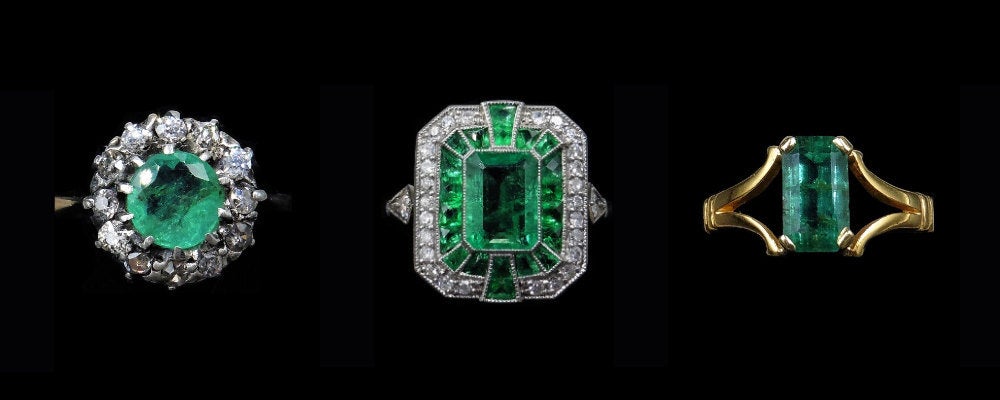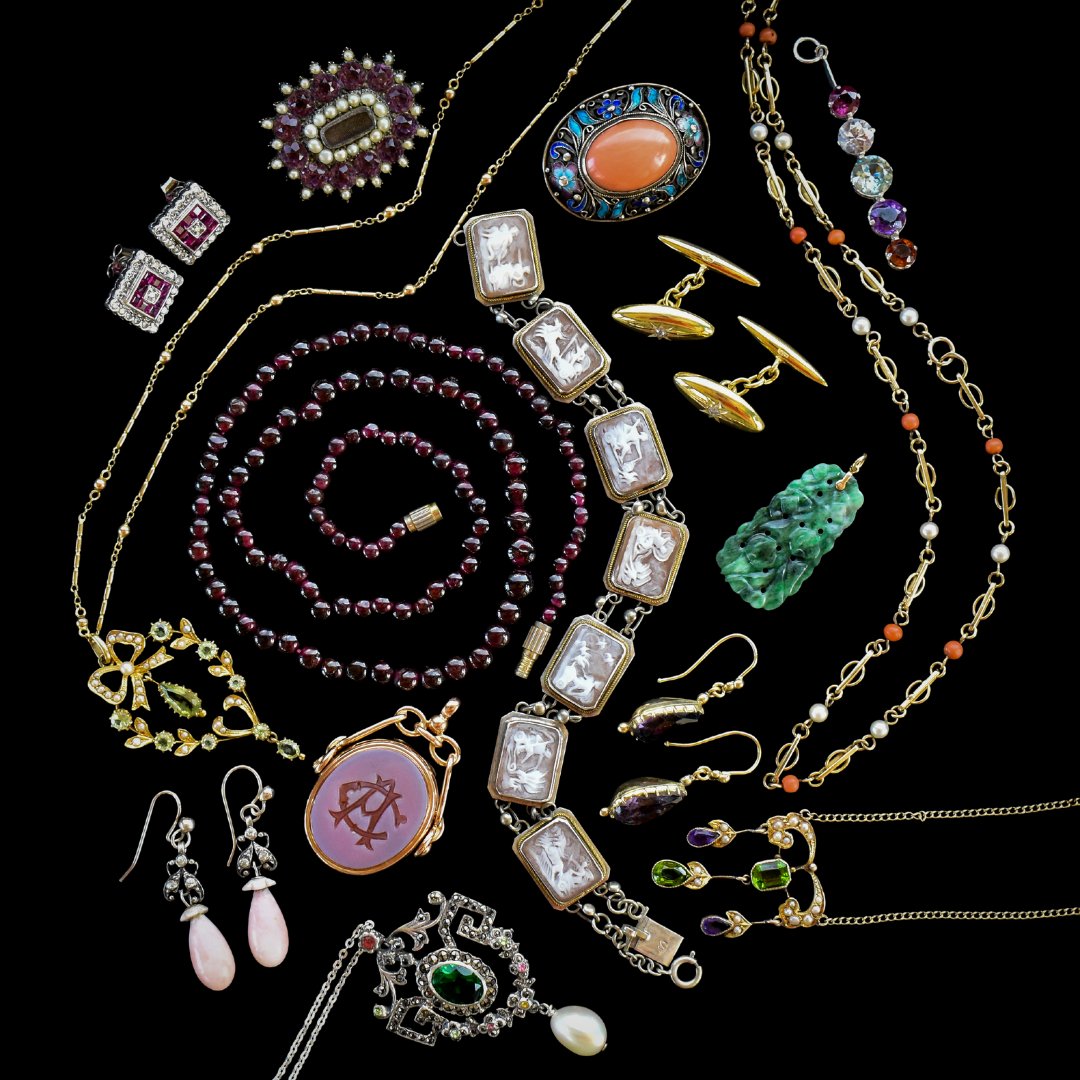Birthstones are gemstones which represent the month of a person’s birth. Each month has one, two or three gemstones associated with it, all with hidden meanings and rich in history. Birthstone jewellery makes the perfect personalised gift that can be treasured forever.
January – Garnet

The birthstone for January is Garnet. Garnet is commonly found in a rich, fiery red shade although they are also found in almost every colour except blue.
Garnet derives its name from the Latin word ‘granatum’, meaning seed, this is due to the resemblance of a pomegranate seed.
Dating back to early Egyptian, Greek and Roman times; Garnets have remained popular throughout all of the jewellery eras. They became particularly popular during the Victorian era, as the stone became a symbol of peace, prosperity and good health.
The garnet is a fairly durable gemstone, ranking 6.5-7.5 on the Mohs scale.
February – Amethyst

The birthstone for February is Amethyst. Known for its deep violet colour, Amethyst is a member of the quartz family and has been used for over 2000 years.
Throughout history Amethysts have been highly valued and have even been favoured by royalty. Today they have become more affordable but remain very desirable for their colour and durability, with a 7 on the Mohs scale.
March – Aquamarine


The birthstone for March is Aquamarine. Aquamarine is often a pale pastel blue and the name translates to ‘water of the sea’ after it’s ocean-like colouring.
Historically, Aquamarine has been used by sailors to grant them a safe passage across the seas. It was also thought to bring you youth and good health and has been associated with calmness, peace and loyalty.
Aquamarine, similar to Emeralds, is a variety of a mineral called beryl. Aquamarine has a rating of 7.5 to 8 on the Mohs scale, making a durable gemstone for jewellery.
April – Diamond

The birthstone for April is Diamond. Diamond is the hardest gemstone of all and is made up of just one element: carbon.
Its structure makes it 58 times harder than anything in nature. A diamond can only be cut with another diamond, making for a rating of 10 on the Mohs scale.
It’s sparkle and durability has made it the gemstone most popular for engagement rings and also the most highly prized of all gems.
Diamond gemstones come in several colours, including brown, yellow, red, pink, blue, and green.
Representing affection, eternity and everlasting love, diamonds are also believed to give you courage and strength.
May – Emerald

The birthstone for May is Emerald. Deriving its name from the Greek word ‘smaragdus’, meaning green, Emeralds are a form of Green beryl.
Emeralds became known as queen Cleopatras favourite gemstone and she used the gemstone in all of her royal adornments.
Emeralds signify re-birth as well as youth, vitality and good fortune. The perfect gemstone for Spring, it is highly valuable and favoured by many royals.
June – Pearl, Moonstone and Alexandrite

June is only one of the two months that has three associated birthstones: pearl, alexandrite, and moonstone. With a spectrum of colour options, price points and qualities, June babies are spoilt for choice!
The most common and ancient birthstone for June is Pearl.
Pearls are thought to be timeless, elegant and pure and although not a natural mineral like other gemstones, Pearls have been used in jewellery for centuries.
Pearls are organic gems which grow inside living organisms – oysters and mussels. Natural pearls form naturally whilst cultured pearls are intervened by man.
Cultured Pearls became accessible during the 1920’s and since then they have flooded the market, making natural Pearls highly sought after and very expensive.
Dating to at least as far back as ancient Greece, Pearls were thought of as the tears of the gods. Similarly, Pearls have been known for use in mourning jewellery to signify the tears shed.
July – Ruby

The birthstone for July is Ruby. Ruby is considered to be the king of gems, known for its vibrant red colour it is thought of as the stone of love.
Burma has been a significant ruby source since at least 600 AD. Burmese rubies are still some of the most prized of all ruby gems.
Rubies are one of the hardest natural gemstones after Diamond, measuring a 9 on the Mohs scale.
It was believed Rubies protected the wearer from evil as well as creating good fortune and success in love.
August – Peridot

Peridot is the most common birthstone for August however Sardonyx and Spinel are also associated with the month.
Peridot is easily recognised for its grassy green colour – ranging from lime green to olive green it is the perfect gemstone for summertime.
Peridot is a very old gemstone, found in Egyptian jewellery from as early as the 2nd millennium BC.
The stone is said to attract love, ward off negative emotions and sooth nerves.
September – Sapphire

The birthstone for September is Sapphire. A favourite of royalty, Sapphire derives its name from the Latin word ‘sapphirus’, meaning blue stone.
Although most commonly thought of a blue, Sapphires can also be found in pink, orange, clear, yellow and many other colours.
Sapphires symbolise loyalty, nobility and integrity. They and are said to focus the mind, encourage self-discipline and channel higher powers.
Sapphires are another popular choice for engagement rings, with a 9 on the Mohs scale, this stone is relatively hard and ideal for everyday wear.
October – Opal and Tourmaline

The birthstones for October are Opal and Tourmaline.
The most traditional birthstone is Opal which reads ‘to see a change of colour’ in Greek. Durning the Middle Ages, Romans believed it was the most powerful gem because Opals hold the colours of all of the other gemstones combined.
Romans also believed that Opals brought good fortune and enhanced imagination and creativity.
The colouring of Opals is caused by millions of tiny silica spheres which diffract the light to display different colours of the rainbow.
First discovered in Australia, the country has since produced around 95% of the world’s Opal supply.
November – Topaz and Citri

The birthstones for November are Topaz and Citrine.
Topaz is considered the original birthstone for the month of November, coming in shades of brown, green, red, pink, yellow or blue – with blue topaz being the most popular in jewellery.
The Ancient Greeks believed topaz heightened strength and could even make you invisible, while the Egyptians associated the golden gem with the sun god.
Topaz has a hardness of 8 on the Mohs scale, making it a fairly hard and durable gem.
December – Turquoise, Zircon and Tanzanite

All three of December’s birthstones are best known for their beautiful shades of blue. These gemstones range from the oldest on Earth to one of the first mined, to one of the most recently discovered.
The first birthstone for December is Tanzanite. Tanzanite is a relatively modern stone in jewellery first discovered in the foothills of Mount Kilimanjaro in the 1960s. It can still only be found in one part of the world – Tanzania.
Secondly, we have Turquoise.
From ancient Egyptians to Persians, Aztecs and Native Americans, kings and warriors alike have admired turquoise for thousands of years. It adorned everything from jewellery to ceremonial masks to weapons and head pieces. Turquoise was thought to possess many beneficial powers, such as guaranteeing health and good fortune.
Finally, we have Zircon. Zircons come in many colours, but blue is perhaps the most popular.
Zircon is known for its high dispersion and fire. White or Clear Zircon is often used to imitate diamonds due to their brilliance and dispersion similarities.
In the middle ages, Zircon was said to aid sleep, bring prosperity, and promote honour and wisdom in its owner.
Conclusion
Birthstones hold a deep historical and symbolic significance, with each gem representing unique qualities and characteristics tied to its respective month. These stones have been treasured for centuries for their beauty, symbolism, and connection to personal identity. Whether used in jewellery or as meaningful gifts, birthstones offer a timeless way to celebrate individuality and personal milestones, making them an enduring part of jewellery traditions.

Here at Lancastrian Jewellers, we stock a great range of jewellery from antique pieces to modern classics, we have something for everyone.You can browse more of our gemstone jewellery here. Please get in touch if you need any further help finding the perfect piece of jewellery.
Further Reading:
If you'd like to expand your knowledge on Gemstones even further, we recommend taking look at the links below.
- A Beginner’s Guide to Gemstones For Jewellers and Stone Lovers - Haywoods jewellery
- Gemstone Buying Guide - The National Association of Jewellers
- Birthstone Chart - International Gem Society





